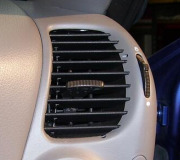Nope. This is actually making more sense now. Imagine if you had a garden hose with a pressure gauge on the end. With the faucet on the house open, and the nozzle on the hose closed, you find 12 pounds of pressure. Now stick your foot somewhere in the middle of the hose so it's 99 percent blocked. You'd still see 12 pounds of pressure. Now open the nozzle and try to get some water out of it that you can do some work with. All you'd get is a tiny dribble. The pressure would drop to 0 psi.
This is what commonly happens on cars when we use the more expensive digital voltmeter. You would have gotten different results if you had used a test light. Voltmeters measure electrical pressure, (voltage), just like the pressure gauge at the end of the hose. Test lights work by lighting their bulb's filament from current flowing through it. That means the circuit must be turned on and current is flowing. Your garden hose nozzle was turned on, but no current could flow because your foot created a restriction.
In your case, you measured 12 volts because you had the connector unplugged. No current was trying to flow, so the voltmeter picked up the voltage that made it through some huge restriction. Once you plugged in the connector, there was a path for current to flow through the clutch coil. That's the same as opening the nozzle on the hose. In the hose, the 12 pounds of pressure was dropped across the restriction caused by your foot. In your car, the 12 volts is being dropped across some restriction as yet to be located.
As a point of interest, this is a real common problem that confuses a lot of mechanics when working on dead radiator fans. Many are protected by fuse link wires which are smaller-diameter wires that are the weak link in the chain. Their insulation is designed to not burn or melt. The problem is when they burn open, that leaves a carbon track behind where the arcing occurred. You'll never get any current through that break to run a fan motor, but when it's unplugged, that carbon track lets enough current through for the voltmeter to "see" the full 12 volts. To avoid this incorrect test result, the test light is more accurate than the voltmeter, or just be sure to always take voltage readings with the circuit fully intact, meaning everything is plugged in and connected.
If you haven't already, switch the "WAC" relay with one of the other ones like it. Assuming that doesn't solve the problem, remove the relay, then test for voltage on the four terminals in the socket. I can't tell from the diagram if you should find 12 volts on one or two terminals. If you don't find 12 volts on any terminal, check the "AC fuse". That's a 15-amp. 12 volts should be there when the ignition switch is on.
Regardless if you find voltage on one or two terminals, remove the "PCM Power" relay, then see if any voltage went away in the "WAC" socket.
Another way to do this is to check for those voltages with the engine running. That will insure the "PCM Power" relay is on, and that means 12 volts will show up at one "WAC" terminal. At that point we know we're supposed to have voltage on two of those terminals. You'll need to remember which terminal gets 12 volts when, so we can figure out where to go next.
Friday, December 29th, 2017 AT 6:13 PM



